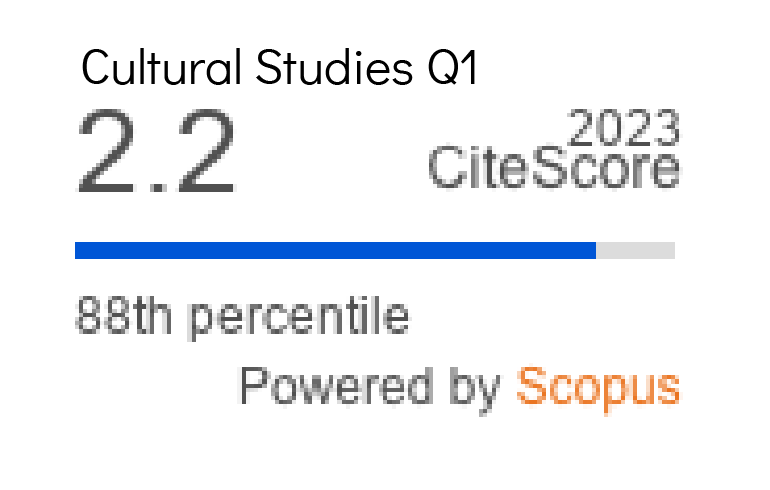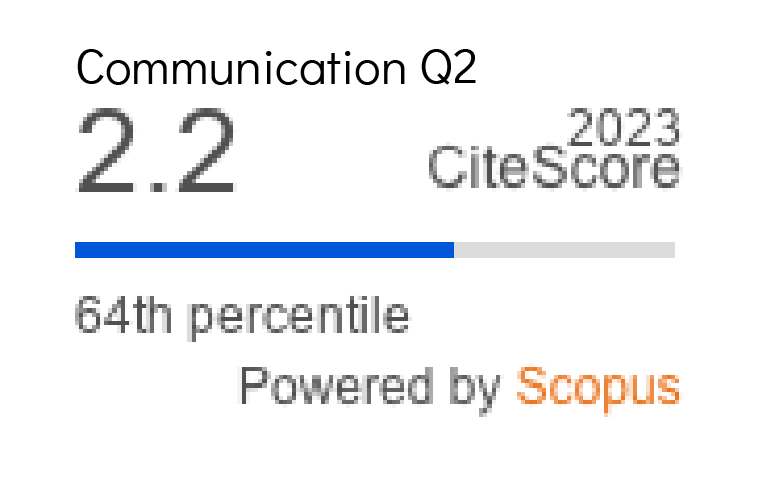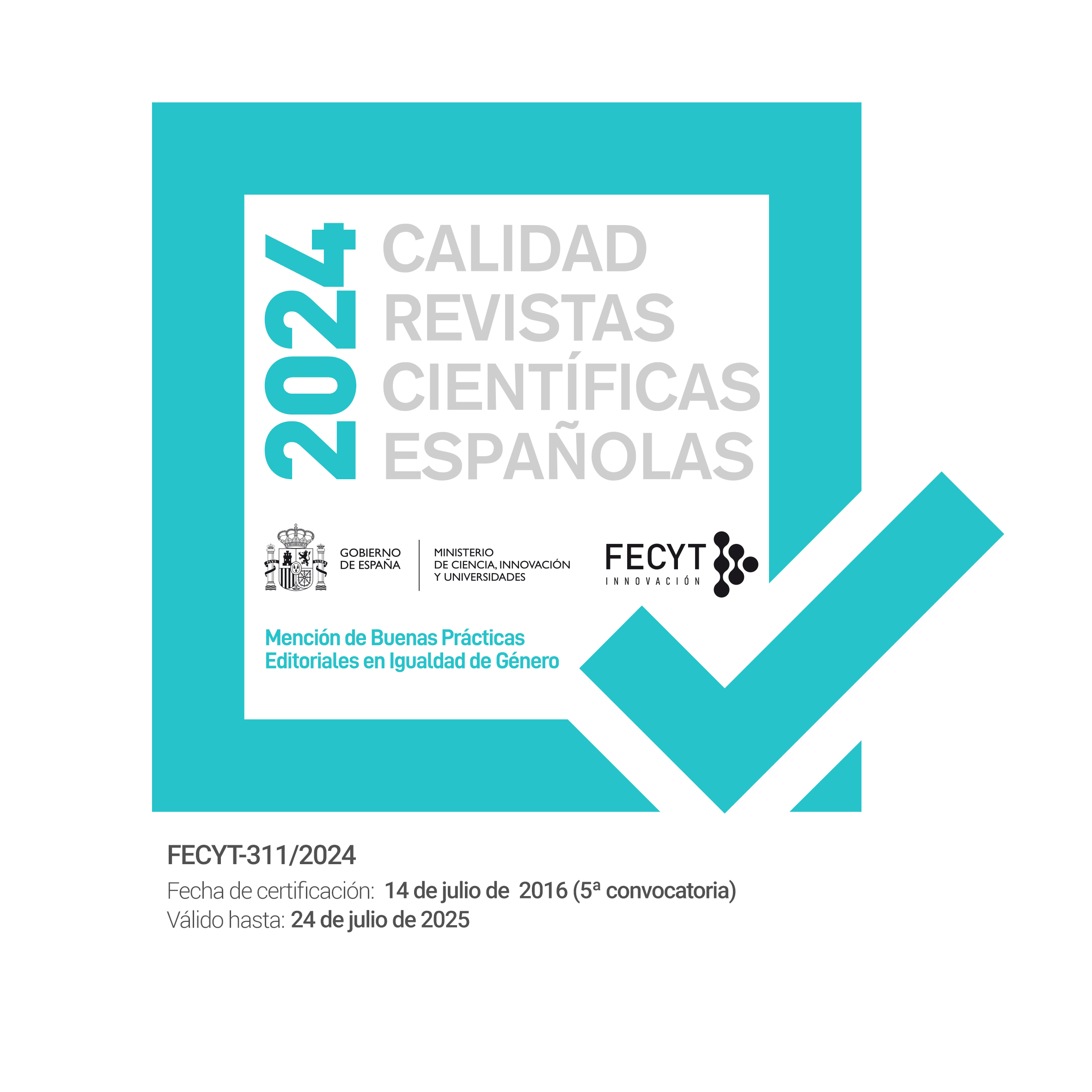Una revisión de los condicionantes de la profesión periodística desde la perspectiva sociológica de McNair ¿Es viable un periodismo profesional de calidad?
DOI:
https://doi.org/10.14198/MEDCOM2016.7.2.16Palabras clave:
Ética de la comunicación, McNair, Presiones mediáticas, Periodismo, SociologíaResumen
La actividad periodística se ha visto sometida en los últimos años a una transformación radical fundamentada, principalmente, aunque no sólo, en la revolución tecnológica que ha incrementado exponencialmente las posibilidades de unos medios además siguen lidiando con los condicionamientos procedentes de los entornos políticos, económicos, profesionales y sociales. Ante este nuevo escenario, se plantea una pregunta inmediata: ¿sigue resultando viable un periodismo profesional y de calidad con los condicionantes actuales? Este artículo trata de dar respuesta a la pregunta de investigación desde una revisión actualizada de la perspectiva sociológica sobre la que McNair analiza los factores que condicionan la profesión.
Citas
AIRA FOIX, T. (2009). Los spin doctors: Cómo mueven los hilos los asesores de los líderes políticos. Barcelona: Editorial UOC.
ALLAN, S. (2010). News Culture. Berkshire: McGraw-Hill.
_____ (2011). Reweaving the Internet : online news of September 11. En ZELIZER, B. y ALLAN, S. (Eds.) Journalism after September 11.Oxon: Routledge.
ANDERSON, P.J., WILLIAMS, M. & OGOLA, G. (2013). The Future of Quality News Journalism: A Cross-Continental Analysis. Londres: Routledge.
ASPINALL, C. (2005). The News Monopoly. Free Press, Journal of the Campaign for Press and Broadcasting Freedom,144.
BECKER, L.B. y VLAD, T. (2009). News Organisations and Routines. En WAHL-JORGENSEN, K. y HANITZSCH, T. (Eds.). The Handbook of Journalism Studies. Nueva York: Routledge.
BIELSA, E. (2008). The pivotal role of news agencies in the context of globalization: a historical approach. Global Networks, 8, 3, 347–366. https://www.doi.org/10.1111/j.1471-0374.2008.00199.x
BISHOP, R. (2001). News Media, Heal Thyselves: Sourcing Patterns in News Stories about News Media Performance. Journal of Communication Inquiry, (25)1,22-37. https://www.doi.org/10.1177/174804851038673910.1177/0196859901025001003
BORRAT, H. (2002). Paradigmas alternativos y redefiniciones conceptuales en comunicación periodística. Anàlisi, 28, 55-57.
_____ (2005). Periódicos de calidad: primeras propuestas para una lectura crítica. Portal Comunicación. Disponible en http://www.portalcomunicacion.com/lecciones_det.asp?id=21.
BOYKOFF, M.T. (2007). From convergence to contention: United States mass media representations of anthropogenic climate change science. Transactions of the Institute of British Geographers, 32(I4), 77–89. https://www.doi.org/10.1111/j.1475-5661.2007.00270.x
____ (2008). Media and scientific communication: a case of climate change. Geological Society, 305, 11-8. https://www.doi.org/10.1144/SP305.3
BRANNON, J. (2008). Maximize the Medium: Assessing Obstacles to Performing Multimedia Journalism in Three U.S. Newsrooms. En PATERSON, C. y DOMINGO, D. (Eds.). Making Online News: The Ethnography of New Media Production. Nueva York: Peter Lang.
BRANTS, K. & VAN PRAAG, P. (2006). Signs of Media Logic Half a Century of Political Communication in the Netherlands. Javnost - The Public: Journal of the European Institute for Communication and Culture, 13, (1), 25-40. https://www.doi.org/10.1080/13183222.2006.11008905
CHADWICK, A. (2006). Internet Politics: States, Citizens, and New Communication Technologies. Oxford: Oxford University Press.
CZARNIAWSKA, B. (2011). Cyberfactories: How News Agencies Produce News. Cheltenham: Edward Elgar Publishing.
DE BURGH, H. (2013). Investigative Journalism. Londres: Routledge.
DEUZE, M., ELEFANTE, P., STEWARD, B. (2010). Media Work and the Recession. Popular Communication: The International Journal of Media and Culture, 8(3). https://www.doi.org/10.1080/15405702.2010.493428
D’HAENENS, L., HOGHE, M., HASIBE, G. & VANHEULE, D. (2006). 'New' Citizens, New Policies?: Developments in Diversity Policy in Canada and Flanders. Gante: Academia Press.
FENTON, N. (2009). New Media, Old News: Journalism and Democracy in the Digital Age. Londres: Sage.
FISKE, J. (2016). Media matters. Oxon: Routledge.
FRANKLIN, B. (2008). Pulling Newspapers Apart: Analysing Print Journalism. Londres: Routledge.
GELADO, R. (2009). La dependencia de la prensa española hacia las agencias de noticias. Comunicación y Sociedad, XXII, (2), 243-275.
GRAY, J. ; CHAMBERS, L. ; BOUNEGRU, L. (2012). The Data Journalism Handbook. Sebastopol (CA): O’Reilly.
HALL, S.; CRITCHER, C.; JEFFERSON, T.; CLARKE, J.; y ROBERT, B. (2013). Policing the crisis: mugging, the state, and law and order. Londres: Palgrave McMillan.
HALLIN, D.C. y MANCINI, P. (2008). Sistemas mediáticos comparados : tres modelos de relación entre los medios de comunicación y la política. Madrid: Editorial Hacer.
_____ (2010). Western Media Systems in Comparative Perspective. En CURRAN, J. y GUREVITCH, M. (Eds.). Mass Media and society. Londres: Arnold.
HABERMAS, J. (2011). The structural transformation of the public sphere. Cambridge: Polity Press.
HALLIN, D.C. y MANCINI, P. (2010). Western Media Systems in Comparative Perspective. En CURRAN, J. y GUREVITCH, M. (Eds.). Mass Media and society. Londres: Arnold.
HANDLEY, R.L. & RUTIGLIANO, L. (2012). Journalistic field wars: defending and attacking the national narrative in a diversifying journalistic field. Media, Culture & Society, 34 (6), 744-760. https://www.doi.org/10.1177/0163443712449500
HANSEN, A. (2011). Communication, media and environment: Towards reconnecting research on the production, content and social implications of environmental communication. International Communication Gazette, 73 (1-2), 7-25, https://www.doi.org/10.1177/1748048510386739
HARVEY, S. (2014). Encyclopedia of Social Media and Politics. Londres: Sage.
HARDY, J. (2014). Critical Political Economy of the Media: An Introduction. London: Routledge.
HASKOVEC, S. (1983). La agencia de prensa en el sistema de los medios de comunicación. Praga: OIP.
HIRSH, P. M. (1980). Occupational, organizational and institutional mass media research. Toward and integrated frame work. Mass Communication Review Year Book, vol. 1.
HORVIT, B. (2006). International News Agencies and the War Debate of 2003. International Communication Gazette, 68(5-6), 427-447.
JACKSON, P.T. (2009). News as a Contested Commodity: A Clash of Capitalist and Journalistic Imperatives. Journal of Mass Media Ethics, 24(2-3), 146-63, https://www.doi.org/10.1080/08900520902905349
JOHNSTON, J. (2009). ‘Not wrong for long': The role and penetration of news wire agencies in the 24/7 landscape. Global Media Journal - Australian Edition, 3(2).
JOHNSTON, J. & FORDE, S. (2011). The Silent Partner: News Agencies and 21st Century news. International Journal of Communication, 5.
KOVACH, B. y ROSENSTIEL, T. (2012). Los elementos del periodismo. Madrid: Aguilar.
LEWIS, J., LEWIS, A. & FRANKLIN, B. (2008). A compromised Fourth State? UK news journalism, public relations and news sources. Journalism Studies, 9(1).
https://www.doi.org/10.1080/14616700701767974
LIPPMANN, W. (1922). Public Opinion. New York: Macmillan.
MANNING, P. (2000). News and News Sources. A critical introduction. Londres: Sage.
MCCHESNEY, R.W. (2011). Corporate Media and the Threat to Democracy. Nueva York: Seven Stories.
MACGREGOR, B. (1997) Live, direct and biased?: Making Television News in the Satellite Age. Londres: Arnold.
MCCOMBS, M.E. (1992). Explorers and surveyors: Expanding strategies for agenda setting research. Journalism Quarterly, 69(4). https://www.doi.org/10.1177/107769909206900402
MCCOMBS, M.E. y SHAW, D.L. (1993). The evolution of agenda-setting research: Twenty-five years in the marketplace of ideas. Journal of Communication, 43(2). https://www.doi.org/10.1111/j.1460-2466.1993.tb01262.x
MCNAIR, B. (1998). The Sociology of Journalism. Londres: Arnold.
MCQUAIL, D. (2010). Mass Communication Theory. London : Sage.
MILIBAND, R. (2009). The state in Capitalist society. Londres: Merlin Press.
MURRELL, C. (2014). Foreign Correspondents and International Newsgathering: The Role of Fixers. Londres: Routledge.
OBIJIOFOR, L. y HANUSCH, F. (2011). Journalism Across Cultures: An Introduction. Nueva York: Palgrave Macmillan.
PARK, R.E. (1922). The immigrant press and its control. Nueva York: Harper and Brothers.
_____ (1969). News as a form of knowledge : A chapter in the Sociology of knowledge. En STEINBERG, C.S. y BLUEM, W.A. (Eds.). Mass Media and Communication. Nueva York : Hastings House.
PARK, R.E. y BURGUESS, E.W. (1921). Introduction to the science of Sociology. Chicago : The University of Chicago Press.
PATERSON, C. (2007). International news on the Internet. Ethical Space, The International Journal of Communication Ethics, 4(1/2). http://dx.doi.org/10.1016/S1097-8690(07)71273-8
POTTER, W.J. (2012). Media Effects. Londres: Sage.
PRESTON, P. (2008). Making the News: Journalism and News Cultures in Europe. Londres y Nueva York: Routledge.
RYFE, D.M. (2013). Can Journalism Survive: An Inside Look at American Newsrooms. Cambrige: Polity Press.
SALMAN, A., FARIDAH, I., MOHD YUSOF, H.A., NORMAH, M. & MAIZATUL, H.M. (2011). The Impact of New Media on Traditional Mainstream Mass Media. The Innovation Journal : The Public Sector Innovation Journal, 16(3).
SANDERS, K. (2003). Ethics and Journalism, London: Sage.
SANDRE, A. (2015). Digital Diplomacy: Conversations on Innovation in Foreign Policy. Lanham (MA): Rowman & Littlefield.
SCHLESINGER, P. (1992). Repensando la sociología del periodismo. Estrategias de las fuentes y límites del centralismo de los medios. Estudios sobre las Culturas Contemporáneas, 13, Colima: Universidad de Colima.
SHOEMAKER, P. J. y REESE, S. D. (1996). Mediating the message. Theories of influences on mass media content. Nueva York: Longman.
SHRIVASTAVA, K.M. (2007). News Agencies from Pigeon to Internet. Elgin (IL) : New Dawn Press.
SKOVSGAARD, M. (2013). Watchdogs on a leash? The impact of organisational constraints on journalists’ perceived professional autonomy and their relationship with superiors, Journalism, 15(3), 344-363. https://www.doi.org/10.1177/1464884913483494
SIAPERA, E. & VEGLIS, A. (2012). The Handbook of Global Online Journalism. Oxford: Wiley-Blackwell.
TERZIS, G. (2015). Mapping Foreign Correspondence in Europe. Nueva York y Londres: Routledge.
THOMPSON, J.B. (2011). The Media and modernity. A Social Theory of the Media. Cambridge: Polity Press.
THUSSU, D.K. (2003). Live TV and Bloodless Deaths : War, Infotainment and 24/7 News. En THUSSU, D.K. y FRIEDMAN, D. (Eds.). War and the media: reporting conflict 24/7. Londres: Sage.
TUNSTALL, J. (1971). Journalists at work. Londres: Constable.
_____ (1996). Newspaper Power : The New National Press in Britain. Londres : Clarendon Press.
WEAVER, D. H. y GRAY, R. G. (1980). Journalism and mass communication research in the United Sates. Mass Communication Review Yearbook, 1.
WAHL-JORGENSEN, K. (2010). News Production, Ethnography, and Power : on the Challenges of Newsroom-Centricity. En BIRD, S.E. (Ed.). The Anthropology of News & Journalism: Global Perspectives. Bloomington: Indiana University Press.
WEATHERLY, J.N., PETROS, T.V., CHRISTOPHERSON, K.M., HAUGEN, E.N. (2007). Perceptions of political bias in the headlines of two major news organizations. The International Journal of Press/Politics, 12(2). https://www.doi.org/10.1177/1081180X07299804
WOLF, M. (1987). La investigación de la comunicación de masas. Barcelona: Paidós.
YAN, Y. & BISSELL, K. (2015). The Sky Is Falling: Predictors of News Coverage of Natural Disasters Worldwide. Communication Research. https://www.doi.org/10.1177/0093650215573861
ZELIZER, B. (2004). Taking Journalism Seriously: News and the Academy. Londres: Sage
Descargas
Estadísticas
Publicado
Cómo citar
Número
Sección
Licencia
Derechos de autor 2016 Roberto Gelado Marcos

Esta obra está bajo una licencia internacional Creative Commons Atribución-CompartirIgual 4.0.
Los autores y autoras que publican en esta revista están de acuerdo con los siguientes términos:
1 Derechos de autor. Los autores y autoras conservan sus derechos de autor, aunque ceden a la revista de forma no exclusiva los derechos de explotación (reproducción, distribución, comunicación pública y transformación) y garantizan a esta el derecho de primera publicación de su trabajo, el cual estará simultáneamente sujeto a la licencia indicada en punto 2. Los autores pueden establecer otros acuerdos adicionales para la distribución no exclusiva de la versión de la obra publicada en la revista, siempre que exista un reconocimiento de su publicación inicial en esta revista.
© Los autores.
2 Licencia. Los trabajos se publican en la revista sujetos a la licencia de Reconocimiento 4.0 Internacional de Creative Commons (CC BY 4.0); los términos se pueden consultar en https://creativecommons.org/licenses/by/4.0/
Esta licencia permite a terceros compartir (copiar y redistribuir el material en cualquier medio o formato) y adaptar (remezclar, transformar y crear a partir del material para cualquier finalidad, incluso comercial), siempre que se reconozca la autoría y la primera publicación en esta revista (Revista Mediterránea de Comunicación (RMC) / Mediterranean Journal of Communication (MJC), Universidad de Alicante, DOI de la obra), se proporcione un enlace a la licencia y se indique si se han realizado cambios en la obra.
3 Política de autoarchivo. Se recomienda a los autores que difundan sus trabajos a través de Internet para favorecer una circulación y difusión más rápidas y, con ello, un posible aumento en la citación y alcance entre la comunidad científica y académica, en las siguientes condiciones:
No se permite a los autores depositar en un repositorio institucional o temático, página web propia, etc., las versiones preprint (versión antes de ser evaluada) o postprint (versión evaluada y aceptada para su publicación) de sus trabajos antes de su publicación, pero sí el artículo final publicado (versión del editor).












